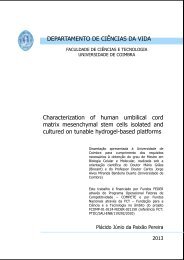role of th1 and th17 cd4+ t cell subsets in the pathogenesis of ...
role of th1 and th17 cd4+ t cell subsets in the pathogenesis of ...
role of th1 and th17 cd4+ t cell subsets in the pathogenesis of ...
You also want an ePaper? Increase the reach of your titles
YUMPU automatically turns print PDFs into web optimized ePapers that Google loves.
28<br />
1.3.4 B CELLS<br />
B <strong>cell</strong>s belong to <strong>the</strong> adaptive immune system through <strong>the</strong> presence <strong>of</strong> unique antigen‐<br />
specific B <strong>cell</strong> receptors (BCR), membrane‐bound immunoglobul<strong>in</strong>s. When B <strong>cell</strong>s are<br />
activated, <strong>the</strong>y can differentiate <strong>in</strong>to memory B <strong>cell</strong>s or plasma B <strong>cell</strong>s <strong>and</strong> <strong>the</strong> latter<br />
produce <strong>and</strong> release large amounts <strong>of</strong> antigen‐specific antibodies, as well as a panel <strong>of</strong><br />
cytok<strong>in</strong>es depend<strong>in</strong>g on <strong>the</strong> <strong>in</strong>flammatory milieu. Ano<strong>the</strong>r <strong>role</strong> <strong>of</strong> B <strong>cell</strong>s concerns<br />
antigen presentation as <strong>the</strong>y also express <strong>the</strong> MHC class II molecule on <strong>the</strong>ir surface.<br />
This is <strong>of</strong> particular importance <strong>in</strong> <strong>the</strong> B <strong>and</strong> T <strong>cell</strong> crosstalk which, as mentioned above,<br />
can contribute to <strong>the</strong> EAE <strong>pathogenesis</strong>. EAE studies showed that <strong>in</strong>jection <strong>of</strong> MOG‐<br />
specific autoantibodies amplified T <strong>cell</strong> attack by <strong>in</strong>creas<strong>in</strong>g <strong>the</strong> severity <strong>and</strong> duration <strong>of</strong><br />
cl<strong>in</strong>ical signs <strong>and</strong> <strong>in</strong>duc<strong>in</strong>g large scale demyel<strong>in</strong>ation (L<strong>in</strong><strong>in</strong>gton et al., 1988). The<br />
presence <strong>of</strong> elevated amounts <strong>of</strong> immunoglobul<strong>in</strong>s (Igs) <strong>in</strong> <strong>the</strong> CSF <strong>of</strong> MS patients was<br />
demonstrated many years ago (Kabat et al., 1950) <strong>and</strong> s<strong>in</strong>ce <strong>the</strong>n, association between<br />
<strong>the</strong> presence <strong>of</strong> CSF Igs <strong>and</strong> <strong>the</strong> MS cl<strong>in</strong>ical worsen<strong>in</strong>g suggested a <strong>role</strong> <strong>of</strong> B <strong>cell</strong>s <strong>in</strong> <strong>the</strong><br />
<strong>pathogenesis</strong>. Clonally exp<strong>and</strong>ed memory B <strong>cell</strong>s have also been found <strong>in</strong> MS CSF <strong>and</strong><br />
lesions. The <strong>in</strong>creased Igs discovered <strong>in</strong> <strong>the</strong> CSF but not <strong>in</strong> <strong>the</strong> serum <strong>of</strong> MS patients<br />
suggested antibody production by local B <strong>cell</strong>s. In fact, a recent report compared <strong>the</strong><br />
transcriptomes <strong>and</strong> proteomes from CSF <strong>of</strong> MS patients. The data obta<strong>in</strong>ed<br />
demonstrated a strong overlap, <strong>in</strong>dicat<strong>in</strong>g that CSF B <strong>cell</strong>s produce <strong>the</strong> oligoclonal Ig<br />
b<strong>and</strong>s (Obermeier et al., 2008). B <strong>cell</strong>s are not able to cross <strong>in</strong>tact BBB but, once<br />
disrupted B <strong>cell</strong>s along with antibodies <strong>and</strong> complement molecules enter <strong>the</strong> CNS. The<br />
auto‐reactive antibodies can cause demyel<strong>in</strong>ation by opsonization <strong>of</strong> myel<strong>in</strong> for<br />
phagocytosis, or via complement activation lead<strong>in</strong>g to antibody dependent<br />
complement cytolysis (ADCC), which can be found <strong>in</strong> MS lesions <strong>and</strong> EAE CNS (Sospedra<br />
<strong>and</strong> Mart<strong>in</strong>, 2005).<br />
1.3.5 INNATE IMMUNE CELLS<br />
Innate immune responses comprise variable functions that range from non‐specific<br />
recognition <strong>of</strong> non‐self molecular structures by Toll‐like receptors (TLRs) <strong>and</strong> release <strong>of</strong><br />
molecules such as nitric oxide, cytok<strong>in</strong>es <strong>and</strong> chemok<strong>in</strong>es, to <strong>the</strong> activation <strong>of</strong> antigen‐<br />
specific adaptive immune responses. The <strong>in</strong>nate immune <strong>cell</strong>s <strong>in</strong>clude DCs,

















